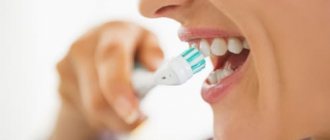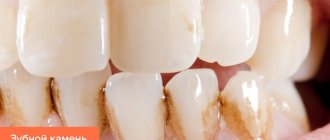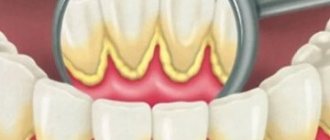The appearance of tartar in children is based on local causes. First of all, these are shortcomings in the organization of everyday oral hygiene. In addition, it can be caused by a limited amount of solid food consumed, which acts as a natural means of cleaning the dental surface.
Another reason lies in the insufficient content of pyrophosphate in the child’s saliva. This component is responsible for counteracting tartar deposits on the tooth surface. Moreover, in the case of children, the boundaries of stone and enamel are often not obvious, and determining the beginning of deposits on the surface of the tooth is very problematic. This is explained by the strong bond between the calcium crystals that make up the deposits.
In dentistry, tartar is usually divided into two categories: subgingival and supragingival. The latter has a pale yellow or gray tint and can be easily removed from the surface of the teeth by scraping. Supragingival plaque is formed from components existing in human saliva. Such stone develops most actively in the area of the lower front teeth and in the area of the upper molars, since it is next to them that the exits of the salivary ducts are located.
Detection of subgingival stone is possible only when visiting a dental office. This type of stone is formed from substances that make up the gingival fluid. In most cases it is a dark brown or green color. It is formed mainly on the neck of the tooth or the cementum of the root. It is characterized by a high degree of adhesion to the tooth surface and the formation in some cases of full-fledged protrusions.
How does tartar form on baby teeth in children?
The formation of tartar in children under 3 years of age, and in adults as well, begins with the deposition of soft bacterial plaque, which undergoes progressive calcification: calcium phosphate minerals are deposited both within and between the plaque bacteria, and then again covered with a layer of plaque. Thus, a hard mineralized plaque appears on the teeth, mainly in the front part, which cannot be removed with a children’s toothbrush. The usual color of tartar in adults is brown. But in children under 3 years old it is usually green. According to dentists, the appearance of such plaque is associated with the vital activity of chromogenic microorganisms containing chlorophyll, which, as we know, is green.
Diagnosis and treatment methods of Priestley plaque
The appearance of black plaque can be the result of various diseases. In order to prevent them from starting and to prevent the development of complications, it is necessary to carry out a number of diagnostic measures. Even if a small spot appears on a tooth, you should visit a doctor and undergo laser diagnostics.
If it is caries, then at an early stage of development it is much easier to cure. In addition, the doctor may prescribe additional tests: blood and urine tests. Depending on the results obtained, appropriate treatment methods are selected:
- If problems with the gastrointestinal tract are identified, it is necessary to review the child’s nutritional system. In this case, a special diet is prescribed and some foods are excluded from the diet.
- Lack of calcium or excess iron can be easily treated by taking corrective medications and eating certain foods in greater or lesser quantities.
- When identifying caries at an early stage , dental procedures such as silver plating or fluoridation can help. The doctor treats the teeth with a special solution, which helps prevent further development of the disease and wait for healthy permanent teeth.
- Common Priestley plaque can be removed by professional cleaning by a doctor. But, unfortunately, this is not a guarantee that it will not appear again after a while.
If stains or plaque on the teeth cause pain or discomfort to the child, fillings are used to preserve the teeth and eliminate discomfort.
Causes of tartar in children
Local factors play a large role in the formation of tartar in a child aged 2 years and older. First of all, this is poor oral hygiene in children. Also, the causes of tartar include insufficient consumption of solid foods. In addition, the occurrence of a large amount of tartar may be a consequence of the lack of pyrophosphate in the saliva, which retards the development of dental plaque, or the lack of a certain protein in the saliva, which slows down the growth of crystals. The presence of tartar on children's teeth is not always obvious. Calcium phosphate crystals can be closely bound to the surface of the enamel, making it often difficult for the dentist to discern where the enamel ends and the stone begins.
Hardware ultrasonic cleaning.
This is the most popular and effective way to remove mineral deposits. Ultrasonic waves break up tartar and easily remove it from the enamel surface. Moreover, such cleaning has an antiseptic effect and is therefore also indicated for gum inflammation. If the stone formation is very dense, before the cleaning procedure, means are used to soften it, then ultrasonic removal of deposits is carried out. During ultrasonic cleaning in the area of the neck of the lower incisors, when the roots are exposed, there may be mild pain. Then, at the request of the patient, local anesthesia is applied.
Despite the presence of many contraindications for the use of ultrasonic toothbrushes, the use of ultrasonic cleaning when removing stone is necessary. First, the dentist will use visual guidance to avoid areas of thinned, porous enamel. Secondly, one-time professional cleaning does not have as negative an effect on fillings as twice-daily brushing.
Laser cleaning.
The newest non-contact method of removing hard dental deposits is highly effective and absolutely painless. However, the price is much more expensive than ultrasonic. Laser cleaning has the same contraindications as ultrasonic cleaning.
Air-flow
Refers to mechanical methods. A jet of air with a therapeutic abrasive mixture is supplied under pressure, which removes both soft plaque and hard deposits. The gum area may tingle during the procedure. It is less effective than ultrasonic and laser cleaning.
Manual method
Mechanical manual method of beating stones using special tools. Currently, it is outdated due to the painfulness of the procedure, the presence of complications and the emergence of more effective methods. It is used free of charge under the compulsory medical insurance policy in public hospitals or as an additional method of treatment if indicated. Due to the painfulness of the procedure, especially when removing subgingival stones, local anesthesia is performed. It is a relative contraindication for periodontitis due to high trauma.
Types - place of formation and color
In dentistry, there are two types of tartar - supragingival and subgingival. They are distinguished by their location on the surface of the tooth. The first is visible to the naked eye and has a grayish or whitish-yellow color. It is easily removed by scraping. Minerals coming from saliva participate in the formation of supragingival tartar. It is most often localized in the area of the lower front teeth and the buccal surfaces of the maxillary molars, where the ducts of the salivary glands open.
Subgingival tartar can only be detected by a dentist during probing. It is formed due to minerals coming mainly from the gingival fluid. As a rule, it is dark brown in color with a greenish tint, localized on the neck of the tooth within the gingival groove, on the root cement, in the periodontal pocket. Covering the neck of the tooth, the stone is tightly attached to its surface, and often forms protrusions.
Contraindications to ultrasonic brushes
Due to the presence of ultrasonic microvibration, the use of such brushes is not recommended for persons:
- with veneers, fillings and crowns, as their service life is reduced;
- with areas of loose and porous enamel, due to the fact that the development of the carious process accelerates due to the destruction of defective enamel;
- with gingivitis and periodontitis, due to the increased spread of infection by hematogenous route;
- with periodontal disease, as the process of bone destruction accelerates;
- having precancerous changes and cancer, due to the acceleration of the division of atypical cells.
These significant drawbacks significantly limit the use of ultrasonic brushes, since almost 95% of the adult population have certain problems. It is also not recommended to use any power brushes during pregnancy or for people with pacemakers.
Tartar removal in children
How to remove tartar from a child? If you find your child has tartar, the first thing you need to do is make an appointment at a pediatric dentist. On the first visit, the child undergoes professional teeth cleaning: soft plaque and dental deposits are removed. Removal of subgingival tartar in children is carried out using ultrasound under local anesthesia. After the procedure, the doctor explains to parents how to monitor whether the baby is brushing his teeth correctly. Before and after the procedure, the hygiene index is checked, and the rules of oral care are repeated in the presence of parents. After 1 - 2 weeks, an appointment is made to monitor the thoroughness of dental plaque removal.
Ultrasonic toothbrushes
Recently, a new gadget has appeared on the market - an ultrasonic toothbrush. In addition to mechanical cleaning, this brush provides ultrasonic treatment of hard-to-reach areas of the tooth and gums to a depth of up to 4 mm. Ultrasonic waves destroy bacteria and effectively remove pigmentation and deposits when mineralization begins. However, such a brush cannot remove formed tartar; this can only be done by a specialist using professional equipment. In addition, the use of an ultrasonic brush is effective and safe only for people with absolutely healthy teeth.
Prevention measures
- As noted above, the absence of a substance such as pyrophosphate can lead to the formation of tartar. Therefore, some toothpastes contain this component. It stops the mineralization of tartar and prevents the process of new growth. The addition of pyrophosphate to toothpastes to some extent compensates for the lack of a natural analogue in saliva. When choosing a paste with this substance, pay attention to what age children it is recommended for.
- A properly selected children's toothbrush will also help prevent the appearance of tartar in children. It is best to prefer a brush with artificial bristles, since, unlike natural bristles, microorganisms do not form in it. Naturally, you need to remember that you should change your toothbrush every three months. In the meantime, until your child reaches the age when he can brush his teeth on his own, you can use special napkins to clean his teeth. They contain xylitol, which inhibits the growth of bacteria on teeth and gums and cleanses them well of soft plaque. Also relevant in this case are fresh hard fruits and vegetables: apples, carrots, cabbage.
- In order for oral hygiene to be as effective as possible, it is very important to teach your child how to brush their teeth properly. Among the main recommendations of dentists, we highlight the following: first, we clean the upper jaw from the outside and inside, starting from the sides, then the front teeth from top to bottom. On the lower jaw the sequence is the same, only the brush moves from bottom to top. Do not forget about the hygiene of the mucous membranes of the cheeks, palate and tongue, where a large number of bacteria are formed.
- Parents need to monitor their children's oral hygiene and regularly take them to the pediatric dentist. This will help prevent the formation of tartar, which can cause various oral diseases, for example, gingivitis in children, childhood periodontitis, and various types of stomatitis in children. In addition, your child's bad breath will also not bother you. Teeth with children's braces will need special care. Remember that food debris and soft plaque can be easily removed with a toothbrush and toothpaste. Removal of mineralized dental deposits is carried out only by a hygienist using special means and instruments.
Why do you need to remove plaque from your teeth?
Tartar can be discovered by parents themselves, or by a dentist during an oral examination. Even if the deposit is insignificant, it must be removed.
Tartar can cause:
- inflammatory lesions of the gums;
- bleeding and sore gums;
- exposure of roots and loosening of the tooth;
- carious lesion;
- constant bad breath.
Pathological processes that provoke hard deposits on teeth can lead to premature loss of baby teeth, which also has a number of negative consequences.
After the procedure
At the end of the procedure, regardless of the method of stone removal, the dentist must grind and thoroughly polish the enamel.
Sometimes, at the request of the patient, after cleaning, the teeth are coated with a special protective composition against infection and plaque buildup.
Within 15 days after cleaning:
- Do not use bleaching abrasive pastes;
- the use of toothpastes from the “sensitive” series, based on herbs and with an anti-inflammatory effect, is indicated;
- rinses with astringent and soothing properties are recommended;
- Do not eat spicy foods or dyes;
- categorically give up smoking or at least abstain for this period.
Contraindications
Contraindications for hardware teeth cleaning include:
- wearing dentures and braces;
- the presence of implants in the body, including pacemakers;
- ARVI, active stage of tuberculosis, HIV infection;
- oncological diseases;
- pregnancy (or with the permission of an obstetrician-gynecologist);
- childhood, until all baby teeth are replaced.
- pregnancy.
Pregnancy is a relative contraindication to dental cleaning. Dental procedures can be performed during a satisfactory pregnancy with the permission of an obstetrician-gynecologist. If there is a threat of miscarriage or other serious conditions, it will be recommended to postpone the removal of stone deposits and the beauty of the smile.









